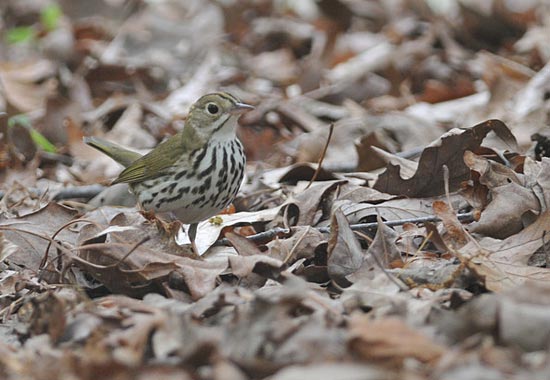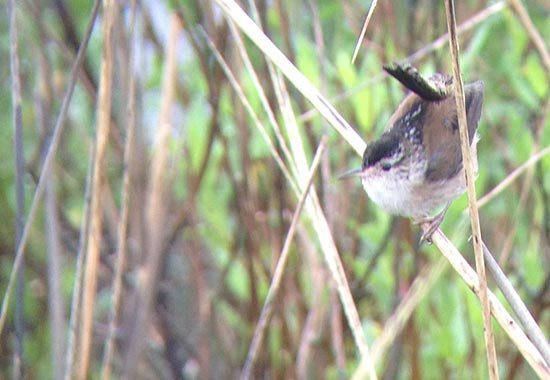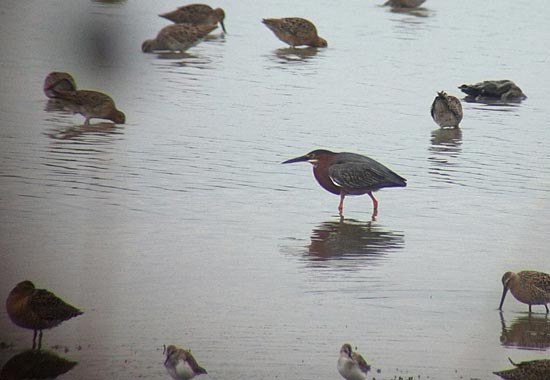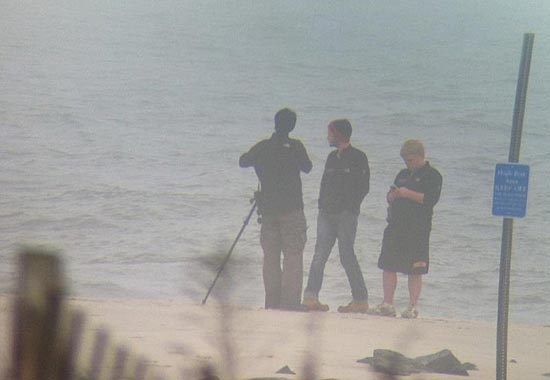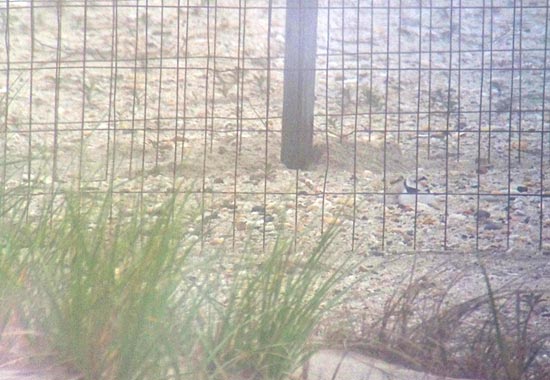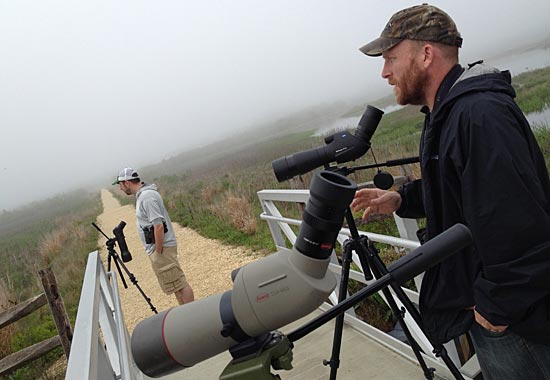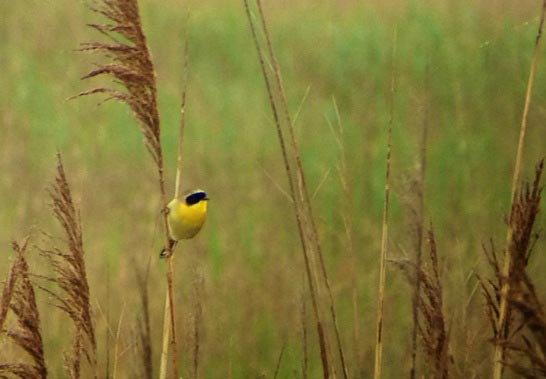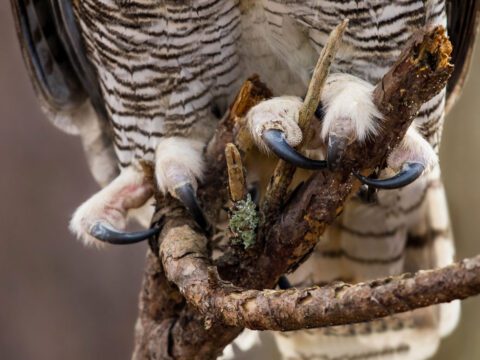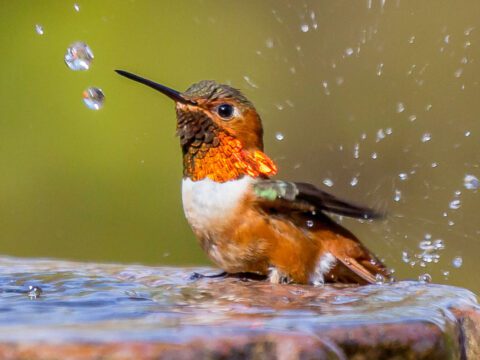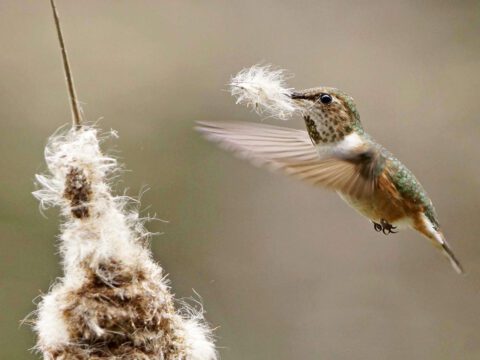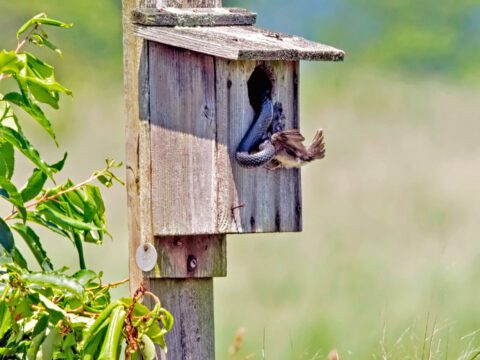Scouting Day 1: Warblers, Sandpipers, Herons, and Rain
By Hugh Powell May 9, 2012
Despite the rain, Ovenbirds still sang loudly in our campground. 
Marsh Wrens were nesting in the saltmarshes of northern Cape May. 
A mess of shorebirds kept a safe distance from a Green Heron at Heislerville. 
The rain led to heavy fog as Team Redhead did their best to scout the ocean. 
An endangered Piping Plover, its black chest band just visible in the mist, nests inside a predator-safe enclosure in Cape May. 
Anti-Petrels France Dewaghe and Hugh Powell scan the Cape May meadows for a Bonaparte's Gull. 
A Common Yellowthroat popped out of the reeds in Tuckahoe marsh.
Lots of bird watchers are obsessive about their hobby, but we still usually regard it as an optional pursuit: when it rains, we’re allowed to stay indoors. But with the World Series of Birding just three days away, our teams—the student Redheads and the bike-powered Anti-Petrels—didn’t really have that option today. Starting at 12:01 a.m. on Saturday, we’ll be spending 24 hours counting as many bird species as we can find to raise money for conservation work. So we need to do our homework.
My Anti-Petrels teammates and I were camping at Belleplain State Forest, and I tracked the progress of the night by the volume of raindrops on my tent fly. They kept getting louder. By the light of morning it was clear the rain was here to stay. But even so, the resident forest birds were singing—an Ovenbird crept through the leaf litter in front of Charles’s tent, then launched into its incredibly loud song. Dogwood blossoms lay on the ground like white confetti, knocked to earth by the rain. Eastern Wood-Pewees wailed in the soggy distance. We brewed three cups of coffee and headed out to see what else was around.
We ran into the Redheads almost immediately. The Lab’s student team were spread along the road listening to Acadian Flycatchers at the traditional haunt of a Louisiana Waterthrush pair. Hope Batcheller, the captain, stood with our captain, France Dewaghe, trading notes on Kentucky Warblers and Summer Tanagers. Her ponytail was dripping. Eric Gulson raised his binoculars at a wall of leaves all twitching with raindrops. He had spied something. Ten minutes later, the waterthrush sang, and we all went on our way.
At a nearby wildlife refuge a Green Heron searched for minnows among thousands of Short-billed Dowitchers, Semipalmated Sandpipers, and Dunlin, a couple of hundred Semipalmated Plovers, and one Ruddy Turnstone. (Among this mixture, it’s imperative on Saturday that we find at least one White-rumped Sandpiper.) The heron’s orange legs flashed above the little shorebirds, which gave it plenty of room—just in case the bird acquired a taste for feathers, it seemed.
We drove out to the beach, but fog enveloped Cape May and visibility was dropping by the hour. By the time we reached the famous Meadows, we could barely see the nesting Piping Plovers inside their predator-safe enclosures. We scoped down the beach and saw the Redheads valiantly peering into the misty waves. Purple Martins emerged out of the mist and sparring Least Terns vanished into it.
People often point out that the World Series of Birding isn’t well-named, since it’s not a series of competitions. But spend some time with a team during Scout Week and it’s apparent that this is both a scramble and an endurance event. A team’s performance on the contest day has a lot to do with how they spend the days leading up to it: how many route variations they’ve tried; how many waking hours they’ve spent scouting dawn locations, night spots, migrant traps, low-tide mudflats and high-tide beaches; and how they’ve balanced patience against luck—the willingness to wait for known birds to appear against the spontaneity to follow the unexpected when it appears in the corner of your eye.
Though we didn’t have a classically great birding day today, we did get some clues about how to refine our route and hopefully top our previous high total of 150 species (the Redheads have a career high of 187 species to shoot for in their category within Cape May County).
The bad weather is supposed to blow through tonight, and a new set of migrants may fly in along with the change—upping the scouting ante for Thursday and Friday. Tomorrow morning at dawn we’ll be in the low woods around the town of Heislerville, listening for the chips of warblers that a month ago were in Mexico. But tonight, after a brief stop in camp, we’re heading out to scout a promising new night spot. If we use it, we’ll be adding more distance to a bike route that already stands at 100 miles. But it could pay off with species such as Least Bittern, Swamp Sparrow, and King Rail that we’re not likely to get elsewhere.
Darkness is falling in camp, bringing to an end the constant shouting of Ovenbirds and starting off a new chorus of frogs. I check around the back of the ranger station to find an Eastern Phoebe tucked neatly onto a nest under the eaves. We found her here last year on a nest during Scout Week, and I wonder how many more of the same birds are around me doing the same things this year, just as we are.
(Thanks to Bob’s Red Mill Natural Foods for sponsoring the Anti-Petrels; to Carl Zeiss Sports Optics for outfitting the Redheads (in part); and to the Woodbine Custard Ranch for providing wi-fi during an emergency. Photos are by France Dewaghe (Ovenbird) Hugh Powell (Green Heron) and Charles Eldermire (others).)

All About Birds
is a free resource
Available for everyone,
funded by donors like you
American Kestrel by Blair Dudeck / Macaulay Library
